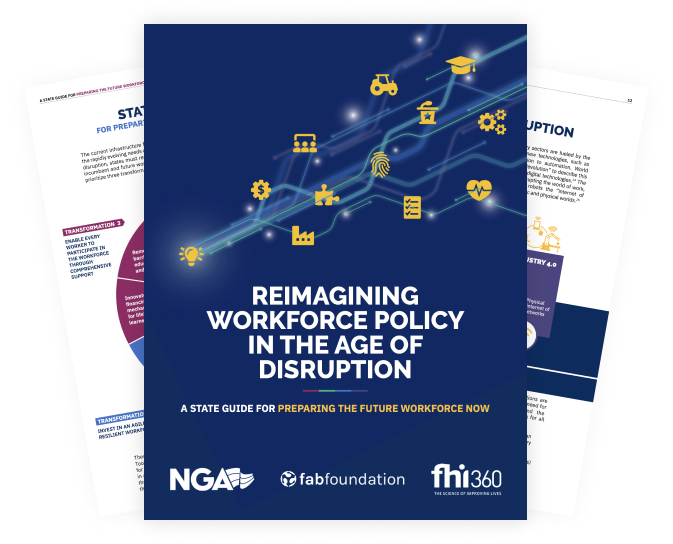Incentivize regional partnerships to build talent pipelines for high-growth industries. States should consider using data to identify in-demand skills sets of high-growth industries, and then conduct outreach to build regional workforce partnerships to fill essential talent pipelines. When successful, these partnerships can inform state education curricula and expand learning requirements for pre- and youth-apprenticeship programs, as well as improve the promotional outcomes of incumbent workers. Over time, these strategies can help states to develop sustainable hiring pipelines for a broad range of workers, including youth and underrepresented or low-income workers.
State Program Examples
-

Iowa
Legislation Requiring Localized Alignment of Training and Services
In order to promote more robust partnerships between education providers and industry, Iowa enacted S.F. 2353 in 2018. This legislation requires local workforce boards to align employment, training education and supportive services in high-demand industries.
-

Idaho
Industry Sector Grants Program
In 2017, former Idaho Governor Otter shifted responsibility for the state’s Workforce Development Training Fund (WDTF) to the Idaho Workforce Development Council to more effectively meet industry needs. The WDTF has been expanded to encourage industry sector and innovation grants which require partnerships among employers, training providers and community organizations to solve local workforce challenges. In addition, an outreach project category was added to the eligible uses of the WDTF to increase public awareness of and access to career education and workforce training.
-

Colorado
NextGen Partnerships
Colorado is home to 30 active sector partnerships that engage employers of all sizes across 79% of the state to increase local alignment between secondary, postsecondary and workforce programs. As of 2019, the Colorado Workforce Development Council reported that 83% of sector partnerships experienced joint or shared decision-making across membership organizations, leading to an increase in the number of individuals entering high-demand career pathways throughout the state.
-

Texas
Created the Tri-Agency Workforce Initiative
In 2019, the Texas Legislature passed transformative school finance legislation in House Bill 3 to reform education and shape the future of the Texas workforce. To fully implement the vision of House Bill 3 in 2020, Governor Abbott charged the Tri-Agency Workforce Initiative to marshal the resources toward streamlining implementation of the legislation and identifying solutions for long-term workforce needs across the state. This builds on the Tri-Agency Workforce Initiative, which was established in 2016, when Governor Abbott established the initiative and tasked the Commissioners of the Texas Education Agency (TEA), the Texas Higher Education Coordinating Board (THECB), and the Texas Workforce Commission (TWC) to work collectively together toward five objectives to develop stronger links between education and industry. At that time, Agency Commissioners together held regional meetings across Texas with the public, as well as leaders from education, industry, government, and nonprofits to understand the state’s workforce needs at a regional level. The direction of this partnership from the governor has since created a strong alliance between the agencies.
-

Oregon
High-Tech Employment Partnership
The Technology Association of Oregon (TAO) is the primary convener of high-tech employers in Oregon and partners with the Lane Workforce Partnership, the designated local workforce investment board. This partnership creates a direct line of communication between tech employers and the workforce board in order to better respond to the evolving workforce needs of the local tech sector. This partnership has led to increased local investment in scholarships for high-tech education and on-the job training contracts with high-tech employers. To build the workforce of the future, states and local workforce boards should consider ways to better represent the interests of the tech sector in order to better inform investment in training and other workforce development programs.
-

Tennessee
Tennessee Talent Exchange
The Tennessee Talent Exchange is a partnership established in 2020 between Hospitality TN, Tennessee Retail and the Tennessee Grocers and Convenience Association. The exchange helps place workers displaced from the hospitality industry as a result of COVID-19 into positions in grocery, retail and logistics industries through an online platform called Jobs4TN.
-

California
High Road Training Partnerships
The High Road Training Partnerships (HRTP) initiative is a $10M demonstration project by the California Workforce Development Board (CWDB) to advance both upward mobility and economic competitiveness by developing industry training partnerships with “high road” employers that offer quality jobs. The CWDB defines a quality job as one that provides family-sustaining wages, health benefits, pension programs, advancement opportunities and collective worker input, and that is stable, predictable, safe and free of discrimination. The HRTP Roadmap to Job Quality also articulates the role of workers, employers, worker organizations, and communities in advancing job quality.














